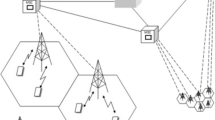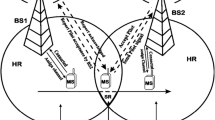Abstract
Wireless networks that utilize dynamic channel allocation (DCA) are known to perform better than those with fixed channel allocation, in terms of the call level QoS measures such as the handoff dropping probability. On account of this, the DCA networks are usually designed without the call admission control (CAC). However, given the decrease of cell sizes, together with ever increasing mobile phone and terminal population, dynamic channel allocation policies (such as channel borrowing) may not be sufficient to cope with the hot-spot area size and its traffic intensity. This paper analyses the performance of the DCA networks, both with and without the call admission control, under the hot-spot traffic regime. In such cases, the pure DCA approach fails to ensure sufficiently low level of QoS in both the hot-spot area and the surrounding cells. We propose a CAC policy that can stabilize the QoS under non-uniform traffic, whilst being easy to integrate in the distributed DCA policies.
Similar content being viewed by others
References
Y. Argyropoulos, S. Jordan and S.P.R. Kumar, Dynamic channel allocation under uneven traffic distribution conditions, in: Proc. of IEEE Int. Conf. on Communications (ICC) (1995) pp. 1855–1859.
F. Barcelo and J. Jordan. Channel holding time distribution in public telephony systems, IEEE Transactions on Vehicular Technology 49(5) (2000) 1615–1625.
D. Bertsekas and R. Gallager, Data Networks, 2nd ed. (Prentice-Hall, Englewood Cliffs, NJ, 1992).
M.M.-L. Cheng and J.C.-I. Chuang, Performance evaluation of distributed measurement-based dynamic channel assignment in local wireless communications, IEEE Journal on Selected Areas in Communications 14(4) (1996) 698–710.
J. Chuang and N. Sollenberger, Beyond 3G: wideband wireless data access based on OFDM and dynamic packet assignment, IEEE Communications Magazine 38(7) (2000) 78–87.
L.J. Cimini, Jr., G.J. Foschini, I. Chih-Lin, and Z. Miljanic, Call blocking performance of distributed algorithms for dynamic channel allocation in microcells, IEEE Transactions on Communications 42(8) (1994) 2600–2607.
E. Del Re, R. Fantacci and G. Giambene, Handover and dynamic channel allocation techniques in mobile cellular networks, IEEE Transactions on Vehicular Technology 44(2) (1995) 229–237.
D.E. Everitt and D. Manfield, Performance analysis of cellular mobile communication systems with dynamic channel assignment, IEEE Journal on Selected Areas in Communications 7(8) (1989) 1172–1180.
Y. Fang, I. Chlamtac and Y.B. Lin, Modeling PCS networks under general call holding times and cell residence time distributions, ACM/IEEE Transactions on Networking 5(6) (1997) 893–906.
C. Jedrzycki and V.C.M. Leung, Probability distribution of channel holding time in cellular telephony system, in: Proc. of IEEE Vehicular Technology Conf. (VTC'96) (1996) pp. 247–251.
S. Jordan and A. Khan, A performance bound on dynamic channel allocation in cellular systems: equal load, IEEE Transactions on Vehicular Technology 43(2) (1994) 333–344.
I. Katzela and M. Naghshineh, Channel assignment schemes for cellular mobile telecommunication systems: A comphrensive survey, IEEE Personal Communications 3(3) (1996) 10–31.
Y.B. Lin and I. Chlamtac, Effects of Erlang call holding times on PCS call completion, IEEE Transactions on Vehicular Technology 48(2) (1999) 815–823.
J. Mišić and Y.B. Tam, On call level QoS guarantees under heterogeneous user mobilities in multimedia networks, in: Proc. of IEEE Globecom’ 99, Vol. 5, Rio de Janeiro (December 1999) pp. 2730–2736.
J. Mišić and Y.B. Tam, Adaptive admission control in wireless networks under non-uniform traffic conditions, Journal of Selected Areas in Communications – Wireless Series 18(11) (2000) 2429–2442.
G.J. Pottie, System design choices in personal communications, IEEE Personal Communications 2(5) (1995) 50–67
R.V. Nee and R. Prasad, OFDM for Wireless Multimedia Applications (Artech House, Boston, MA, 2000).
P.V. Orlik and S.S. Rappaport, A model for teletraffic performance and channel holding time characterization in wireless cellular communication with general session and dwell time distributions, Journal of Selected Areas in Communications 16(5) (1998) 788–803.
T.S. Rappaport, Wireless Communications, Principles and Practice (Prentice-Hall, Englewood Cliffs, NJ, 1996).
S.M. Ross, Stochastic Processes, 2nd ed. (Wiley, New York, 1996).
S.M. Ross, Introduction to Probability Models, 7th ed. (Harcourt/ Academic Press, New York, 2000).
Author information
Authors and Affiliations
Corresponding author
Rights and permissions
About this article
Cite this article
Mišić, J., Tam, Y.B. Non-Uniform Traffic Issues in DCA Wireless Multimedia Networks. Wireless Networks 9, 605–622 (2003). https://doi.org/10.1023/A:1025956401962
Issue Date:
DOI: https://doi.org/10.1023/A:1025956401962




